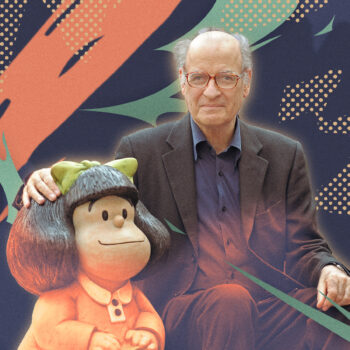No matter where you’re from, most people have heard of Mafalda. The comic strip, written and drawn by Argentinian cartoonist Joaquín Salvador Lavado Tejón, commonly known as Quino, ran from 1964 to 1973 and focused on a six-year-old girl named Mafalda, who showcased the country’s middle class while also reflecting progressive ideas. Always concerned with peace, Mafalda was the more politically minded cousin of Peanuts in the comic strip world, and the world embraced her for it.
For a little girl, Mafalda made it far. The comic strip has been translated into around twenty languages, including Chinese, Japanese, Guarani, Hebrew, and Armenian. The strips were then collected into ten small books named Mafalda, numbered from one to ten. Two series of animated shorts have also been made, and in 2024 an animated series exclusive to Netflix was announced. It will be written by Juan José Campanella.
But how did a comic strip about a little girl become so popular in places like China, Canada, and across Europe? The answer lies in the universality of her message – and the way she seemed to belong to everyone. “It was easy to like Mafalda because Mafalda was funny and she was sassy and she always had a comeback,” Maria Belén, who hails from Spain, told us of the comic strip, which her mother first introduced to her as a little girl. “There was always a Mafalda quote for everything.”
That sentiment feels pretty universal. Mafalda has been a favorite of old and young across many different places, from her native Argentina, to as far away as China. In front of Quino’s old home, in the San Telmo neighborhood of Buenos Aires, there is a life-sized statue of Mafalda people take pictures with. But that is not the only place where you can find her. The city of Gatineau in Quebec, Canada, has a street named after Mafalda, and there is another life-sized statute of the popular little girl in Campo de San Francisco, a park located in Oviedo, Spain.
Earlier this year, there was even a 60th-anniversary exhibit celebrating both Mafalda and her creator, Quino. You’d think such an exhibit would take place in Buenos Aires or somewhere else in Latin America. Instead, it took place in Beijing and it featured the first complete Chinese translation of Mafalda.
“I remember when I was little I wanted to be Mafalda,” Shirley Morin from Canada shared. “Perhaps she’s the reason I grew up to always question everything. I remember reading Mafalda when I was little and she always had questions for her dad. She always wanted to know why her mom didn’t do anything other than stay home and clean and cook. She was very progressive, and now I understand how rare that was for the time. And she made me want to ask questions.” Morin is now an environmental activist.
If entertainment shapes us, it is fair to say Mafalda influenced more than a generation. As social criticism, the comic strip was instrumental in not just sending a message, but in making both children and adults alike think not just about issues like inequality and the role of women, but also about the need for peace and the havoc war wrecks on humanity in general.
“I learned about the Vietnam War from Mafalda,” Martin Gonzalez, who writes comics and grew up in Japan tells us. “And they teach you in school some things, but Mafalda was giving such a clear condemnation of it, such clear opinions in a way my teachers weren’t. This is bad. War is bad. The world is sick. Comic strips can be a means of political criticism. They have been since long before I’ve been alive.”
But Mafalda was also a kid. She had friends, who were sometimes a little annoying, she hated soup – and could never understand why her mom, who protected her from the reality of their family’s financial struggles, kept feeding it to her – and she had a little brother she didn’t always get along with.
Mafalda wasn’t a heroine. She wasn’t a role model. And yet, in many ways, she was. She still is. And she is the kind of universal figure that is very much a part of Latin American culture and that has become an international staple at this point. Mafalda is us, but she is also, at this point, a representation not just of what we are but of how universal our reach can be. Because, even sixty years ago, no one ever looked at her and said, that little Argentinian girl doesn’t get me. She isn’t me.
We’ve always seen each other in Mafalda, no matter where we are in the world. And Mafalda, all of six years old, no matter how much time passes, keeps looking back, her message intact.







